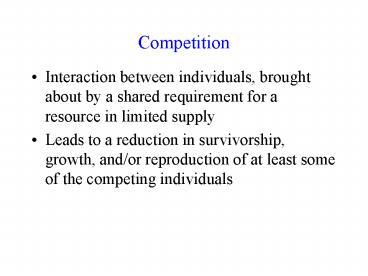Competition - PowerPoint PPT Presentation
1 / 37
Title: Competition
1
Competition
- Interaction between individuals, brought about by
a shared requirement for a resource in limited
supply - Leads to a reduction in survivorship, growth,
and/or reproduction of at least some of the
competing individuals
2
What are competitive species?
- Grime species with capacity for resource
capture and rapid growth, when resources are
readily available defined by mechanism - Tilman species which have a low equilibrium
resource requirement and maintain growth when
resources are limited defined by outcome
3
Quantifying competition
- Competitive effect of a plant on its neighbors
- Competitive response of a plant to its
neighbors - Competitors as defined by Grime, Tilman usually
focus on whether there is a competitive effect
4
Competition and the Niche
- Competition should be most severe when
individuals are similar in resource requirements
or life form - Predict intraspecific competition very high
- Predict that interspecific competition may lead
to niche divergence
5
Intraspecific Competition
- The law of constant yield
6
Intraspecific Competition
- Skewed size distributions
7
Intraspecific Competition
- Emergence order and skewed size distribution
8
Intraspecific Competition
- Self thinning rule, W c N (-3/2)
- Growth occurs only as individuals die but
growth faster than death
9
Intraspecific Competition
- Slope approaches 1 when death balances growth
(e.g. when growth is slow, as in shade)
SUN SHADE
In Lolium perenne
10
Intraspecific Competition
- Variation in allocation strategy with increased
density
In Foxglove Digitalis purpurea
11
Intraspecific Competition
- Variation in allocation strategy with increased
density
In corn Zea mays
12
Interspecific competition
- Studied both in the field (removal, addition
experiments) and in the greenhouse (additive and
replacement designs) - Some controversy about methodology
- Greenhouse expts have greater control
- Difficult to extrapolate from greenhouse to nature
13
Interspecific competition
- Partial additive vs. replacement designs
Additive Replacement
14
Interspecific competition
- Partial additive inappropriate cant
disentangle effects of total density and relative
proportions - Replacement allows comparison of inter- and
intra-specific competition, but results depend
entirely on density chosen
15
Interspecific competition
- Best design multiple replacement series, also
called complete additive series - What we used in labmanipulate both density and
proportion, so can infer relative importance of
both inter- and intra-specific competition
16
DeWit Plots
Yield is normally biomass, absolute (not
relative) values are presented
Species I J
Yield
Dashed expected line if interspecific and
intraspecific competition are equal
Species I
Species J
0.5
1
0
Proportion species I
17
DeWit Plots
18
DeWit Plots
- Model 1 effect of sp I on sp J and vice versa
equivalent to intraspecific competition - Interpretation size may differ between the
species but they have similar niches, ability to
capture and use resources
density
19
DeWit Plots
- Model 2 Asymmetric competition. One species is
a superior competitor, and has a greater
interspecific than intraspecific competitive
effect
20
DeWit Plots
- Model 3 Mutual antagonism. Interspecific
competition greater than intraspecific for both
species.
21
DeWit Plots
- Model 4 Interspecific competition less than
intraspecific competition for both species. May
result from niche divergence.
22
Interspecific competition
- Grime thought competition unimportant in
low-resource environments or highly disturbed
environments - Expect stress tolerators or ruderals
- Tilman argued that competition important in all
environments, but resource being competed for
differed - High resource envts, compete for light low
resource envts, compete for nitrogen
23
Tilmans model
- Zero net growth isoclines (ZNGI) minimum
resource requirements for species - ZNGI relatively lower species a better
competitor for that resource (requires LESS of
it) - ZNGI relatively higher resource can be
considered a limiting factor for the species
24
Tilmans model
R2B
R2A
R1A
R1B
25
Tilmans model
- If ZNGIs overlap, we add consumption vectors (C)
to illustrate how each species uses resources - If each species consumes more of the resource
that limits itself, get coexistence - If each species uses more of the resource that
limits the other species, outcome is unstable
26
Tilmans model
27
Tilmans model
28
Tilmans model
- Unstable outcome unpredictable which species
will exclude the other - Depends on initial conditions relative amount
of each resource, which species present first,
etc.
29
Tilmans experiments
- Start by measuring R the amount of resource
left when a population of a single species
reaches equilibrium density - Species with lowest R should competitively
exclude all others - Focus Nitrogen. In grasslands, below-ground
competition considered more important
30
Tilmans measure of R
Poor competitor
Good competitors
Tilman and Wedin.1991. Ecology 72685-700
31
Tilmans experiments
- Introduce seeds into field plots with known
initial N level - Best competitors will exclude others, as
predicted by R
32
Tilmans field expt.
Tilman and Wedin.1991. Ecology 721038-1049
33
Other factors in competition
- Often diffuse rather than pairwise
- Indirect effects from other species may be
important
34
Competition and indirect effects 1
- Dodder (Cuscuta) in salt marsh changed
competitive relationships
35
Competition and indirect effects 1
Callaway and Pennings. 1998. Oecologia 114
100-105.
36
Competition and indirect effects 2
- Mixtures of rice have reduced disease
transmission
Zhu et al. 2000. Nature 406718-722
37
Competition summary
- Local density may be more important than total
density - Small initial differences in size can have large
consequences later - We can (sometimes) predict the outcome of
competitive interactions, but indirect effects
complicate things (more when we do multitrophic
interactions)































